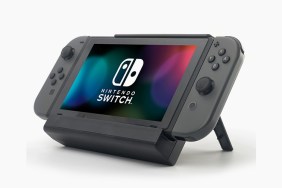The Nintendo Switch presentation rubbed a lot of folks up the wrong way last week, with it serving to undo much of the excitement generated by the console’s debut trailer, instead making many nervous that Nintendo was going to “pull a Wii U” again. As someone who found a lot to love about the Wii U but became increasingly frustrated by its lack of games and third-party support, the presentation certainly hasn’t convinced me that the Switch isn’t going to make the same missteps, and my optimism for Nintendo’s next console has significantly declined as a result.
While I’ve yet to try out the console and can therefore not pass judgement on how accomplished it is, I’m roundly disappointed in what Nintendo has revealed, with the company’s debut presentation brimming with potential problems and the return of some of its most irritating habits. Though I hope that actually getting my hands on the console will dissuade a number of these concerns, the general consensus seems to be a collective “eh,” which isn’t exactly what Nintendo needs if it wishes to reclaim the audience it lost with the Wii U.
Here’s why, in my opinion, the Nintendo Switch looks so disappointing at this juncture:
Emphasis on motion control again

The Nintendo Switch will get us all waggling again.
The debut trailer for the Nintendo Switch put motion control on the back-burner in favor of highlighting the console’s portability, but that wasn’t the case during its presentation last week. Nintendo is returning to the motion control well once again, and while it’s understandable that they would do so, it being placed at the forefront of the Switch event was disheartening. Motion control definitely makes video games more accessible to a wider range of people, which is great, but no amount of “haptic feedback” can make it seem exciting anymore. If the Switch is to follow in the footsteps of the Wii U and Wii, then the Joy-Cons’ motion control will be utilized for a few good games within the console’s launch year, before both Switch owners and Nintendo give up on it and move towards a traditional control method.
Monthly “free” games
Nintendo has always really failed to capitalize on utilizing its unparalleled back catalog of games to shift new hardware, with the Virtual Console being underwhelming, overpriced and nowhere near as good as it has the potential to be considering the company’s lineage. Nintendo’s new paid online service (we’ll get to that later) brings with it one “free” monthly game, except not really. Whereas Microsoft’s Games With Gold and Sony’s Instant Games Collection offers subscribers to its online services a rotating selection of games they get to keep forever, Nintendo is instead basically renting out one of their old NES or SNES games that players get to enjoy for a month, before they’re asked to pay up in order to continue playing it. When you consider just how long these games have been around, Nintendo making them rental only when you’re forking up for its Switch online subscription service seems incredibly stingy, and not a great sign of things to come for how the company will handle a potential new incarnation of the Virtual Console.
Paid online service

The features that will be available to the service’s subscribers. Hardly riveting, is it?
We’re expected to pay for online features for both the PS4 and the Xbox One, but Nintendo rolling out a similar subscription service feels optimistic on the company’s behalf. Nintendo’s support for online multiplayer has been lackluster to say the least, as a result of the company’s refusal to include standard features such as party chat and searchable usernames. The Switch’s online services will be free for a trial period following its launch, but then come Fall 2017 it will require us to fork out cash in order to continue playing the likes of Splatoon 2 online. Unless Nintendo manage to pull something amazing out of the bag and finally nail online gaming despite multiple misfires, then I can’t imagine a lot of people are going to want to commit to investing in whatever the Switch’s online service may be.
Smartphone voice chat
I was put off by the Switch’s paid online service, but my concerns increased considerably after discovering that its voice chat will require either a smartphone or tablet. The Switch’s dedicated app will manage online features such as inviting friends to games, organizing play sessions and voice chat, with Nintendo of America president Reggie Fils-Aime saying that talking to your friends will only be possible using a smart device in order to avoid the console requiring “bulky headsets.” However, considering that these headsets are so prevalent because they represent the best option for players looking to talk with their friends online while still being able to hear a game’s audio, replacing this method by forcing Switch owners to use their smartphone and Switch in tandem seems unnecessarily complicated. Truthfully, no one buys Nintendo consoles for their online capabilities, but if Nintendo is going to want us to cough up money in order to play the likes of Splatoon 2 online, then I’d at least hope that its online service would be simple and functional. Instead, it seems like it’s following the company’s trend of weird decision making that ultimately leads to a less user-friendly experience.
Low storage space

Breath of the Wild will take up nearly half the Switch’s storage space. Yikes.
The Switch has a paltry 32 GB of storage, with The Legend of Zelda: Breath of the Wild taking up almost half of that space by itself, clocking in at 13.4 GB. This storage can be increased using a microSDHC or microSDXC, which currently offer up to 512 GB (though will eventually be able to store up to 2 TB), but this will still mean that many Switch owners will be forced to delete games as their library increases. These storage cards can also be incredibly pricey as their volumes increase (512 GB will run you up around $200), so it’s certainly not an ideal way of expanding the Switch’s storage compared to the interchangeable hard drives of the PS4 and Xbox One. As someone who found myself switching to a 2 TB HDD very early in the PS4’s life cycle, even though the Switch’s games take up less space I’m still certain that 512 GB won’t enough.
Joy-Con price and charging
The Joy-Con controllers have a hefty price point of $79.99 when purchased as a pair, while the left and right Joy-Con can also be purchased individually for $49.99, with the grip that holds them together costing another $30. This grip will be required to charge the Joy-Cons when they’re not attached to the docking station, and will not be sold with the Switch. Although Nintendo has said that the Joy-Cons can last for up to 20 hours of continuous use, you’ll still have to remember to dock them whenever you’re finished with them, and the prices for a separate charger/additional controllers are unfortunately higher than anticipated, too.
Slim launch line-up

1-2 Switch doesn’t look like it’ll be as successful as Wii Sports in highlighting the Switch’s capabilities.
While quality over quantity always rings true, the Nintendo Switch’s meager line-up of five launch games doesn’t offer much in the way of variety. Yes, The Legend of Zelda: Breath of the Wild will likely be one of the most well-received console launch games ever (though it’s releasing on the Wii U, too), but there’s not much else in its release day line-up to get too excited about. Just Dance 2017 and Skylanders Imaginators are hardly the most inveigling options, while 1-2 Switch and Super Bomberman R look moderately interesting rather than genuinely exciting. Sure, launch line-ups for new consoles typically consist of a wide selection of duds or underwhelming releases, but the Switch still offers very little for those who are looking to make a day one purchase. Fortunately, the console’s selection of games will be padded out quite a bit come the Holiday season, with Super Mario Odyssey and Splatoon 2 both on their way.
High price for remasters/ports
The Elder Scrolls: Skyrim will be making its way to the Nintendo Switch, but despite it first being released in 2013 Nintendo has decided that it should be priced at $59.99. Yes, Skyrim — which is nearing its fourth anniversary in June — will cost the same amount of money as the likes of The Legend of Zelda: Breath of the Wild and Super Mario Odyssey. This is despite the game’s Special Edition being available to buy on PS4 and Xbox One for around $35, and it also having been released on the PC in various incarnations for substantially less money along with all the bells and whistles that its modding community has provided. But the madness doesn’t end there, as Nintendo will also be charging $59.99 for Mario Kart 8 Deluxe. Fortunately it will come with an improved battle mode and all the game’s DLC, but even so, a 2014 game being given the same price tag as a brand new release? I’m not on board.






